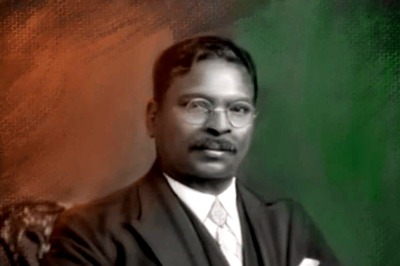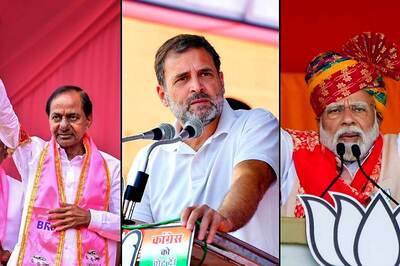
views
It wasn’t by design, but it wasn’t purely accidental either. Sixty-five-year-old Murugesan, who lives at the edge of the line that divides the Yamuna river from a drain, remembers a time decades ago, when the drain had fish in it and the water was fit enough to swim in. Not anymore.
It’s 2:30 pm on a sultry July afternoon. The roar of cars speeding on the Barapullah Elevated Road mingle with the cries from the vegetable market. It is lunch-time and the smell of sambar-rice wafts out from kitchens at the colony for migrant workers from Tamil Nadu. The drain, that was not always a sewer, lies forgotten. The sour stench emanating from it raises a troubling question: what will Delhi do, if or when, it runs out of water?
For centuries, the heart of Delhi acted like a bowl created by the Delhi Ridge. Water flowed down from the slope towards its centre and the Nizamuddin or Barapullah Nalah (often referred to in 19th century maps as a darya or creek), was the largest of these flowing eastward towards the river.
By the 1970s, ‘planned’ development had started to alter these drains and treating them as public dumps. On the other hand, migrants like Murugesan, who were in search of shelter, gravitated towards water and treated the drains like territorial markers in slums at Madangir, Andrews Ganj and Jangpura.
When the first drainage master plan was charted out in 1976 for a city with a population of 60 lakh, it had found 201 natural drains. By 2018, 19 of these had disappeared while the rest had become sewers, found the 2018 Master Plan prepared by IIT Delhi.
Experts explained that the issue underlining all of Delhi’s water woes is the tendency to look at the river, the drains and drinking water, not as a part of an interconnected system — but as unconnected problems waiting to be solved. From 1976 to 2018, the city’s population grew over four-fold - from 60 lakh to an estimated 250 lakh. As the city grew, the rivulets, streams and nallahs were first forgotten and then built over. Diversion and embankments altered the flow of these natural waterways, which were the integral building blocks of Delhi’s three river basins - Barapullah, Najafgarh and Trans-Yamuna, and also recharged groundwater aquifers.
The result: the city was thirsty, like never before, and water was running out.
***
The 1,300 residents in the JJ colony at Barapullah are acutely aware of this change. Access to water isn’t a problem, with taps in each of the 350 homes; there is just less of it. Until 2013, homes got water all day. “Now, we only get it for 3-4 hours,” said Murugesan.
The Madrasi camp.
The Barapullah, like all of Delhi’s 201 drains, plays an important role in recharging groundwater that can then be used for both, potable and non-potable purposes. The water, which is now bluish-green in colour -- symptomatic of its depreciated quality, along with its fast-declining levels -- serves as a painful reminder for Murugesan of what used to be.
The former MCD employee, who moved to Delhi in 1965 and lived in Pant Nagar and Trilok Puri before settling here, is now the community’s pradhan (chief). “We used to swim in the drain when I had first married. Even fish would swim in these waters. Now the drain is not being cleaned at all,” he rued. Everything, he explained, went south after the construction of the elevated road began in 2008. “I used to regularly clean it during my time at the MCD with a JCB operator. But there’s no one to do it now,” Murugesan said.
In an effort to tackle this growing problem, the Delhi government led by the-then Lieutenant Governor Najeeb Jung and the chairman of the DDA in 2014, created a policy that rejected the idea of covering drains. Importantly, it made a distinction between a natural and an artificial drain.
Environmentalist and river-expert Manoj Mishra had written to the L-G and said that he found it “strange and motivated” that the policy restricted the natural drains to just 22 that was mentioned in the DDA’s Delhi Master Plan 2021 and not the numerous smaller drains that were listed by the IIT Delhi report.
An official of the Delhi government’s Irrigation and Flood Control Department told News18 that this hadn’t surprised him. “This is how the DDA operates. They are, first and foremost, a land-owning agency and land is the most important commodity in Delhi. Drains are a nuisance standing in the way of ‘development’.”
The extensive encroachment and rapid development around Barapullah, a significant part of which started around the Commonwealth Games, is what eventually cemented its grim fate.
Pointing out the crucial role of the drain in recharging groundwater, Mishra said “All the drains in Delhi connect to the Barapullah. Water bodies from both the eastern and southern parts of the Delhi ridge come together. So, the entire city should be blamed for its degradation.”
Two years ago, the government undertook the ambitious ‘Local Treatment of Urban Sewage Streams for Health Reuse’ or LOTUS to ‘beautify’ the drain. The project, a joint Indo-Dutch venture that is funded by the Department of Biotechnology, aims to identify nodal points along the drain and the technology that can treat the water. Another problem the project is attempting to address is the misnomer of drains being equitable to sewerage.
Dr Shilpi Kapur, a researcher with The Energy and Resources Institute (TERI), one of LOTUS’ collaborators, is trying to find ways to break down this perception. The method she describes involves “spreading awareness through workshops” in colonies like the one where Murugesan lives.
Today, the Barapullah is a fraction of the problem. The basin accounts for 44 drains of the total 201 in the capital and less than half of the potential for groundwater recharge.
The August 2018 report and Master Plan by IIT’s civil engineering department had asked for a “complete overhaul” to ensure that drains are treated as “key public assets”. It listed out the myriad of ways in which drains had been abused for decades. These range from the Delhi Jal Board puncturing sewer lines in order to drain sewage into stormwater drains, to the increase in paved surfaces reducing water percolation and the dumping of construction debris into natural drains.
65-year-old Murugesan outside his house.
The Delhi government had promised to take action, but the situation on ground is different.
Consider this:
* The Karawal Nagar drain in east Delhi’s trans-Yamuna basin, where the dumped body of a 12-year-old boy was found last year, continues to be filled with garbage. While residents demand that the drain be covered up, not one person viewed the drain as a ‘public asset’.
*At Najafgarh, dirty water slick with oily effluents continue to pour into Delhi from the industrial area of Gurgaon - a problem flagged by the 2018 report.
* The Chirag Delhi drain at Defence Colony is mostly paved, something that prevents water from percolating into the soil, the report stated. Meanwhile, in different spots, the space for the drain was being used for parking instead. The adjacent Andrews Ganj drain that has a small slum next to it, is filled with garbage.
* Parts of the Kalkaji Drain were blocked and residents said that a recent surge in construction work in the area had led to debris being dumped into the drain.
* The 2018 Master Plan had recommended that “efforts should be made to be put all the stormwater drains under a single agency that shall take care of many issues identified”. But, DJB vice-chairperson Dinesh Mohaniya said that stormwater drains continue to be controlled by a different agency. “The systems are different,” he said.
**
Back at the Barapullah, in a slum behind the Madrasi camp JJ cluster, 70-year-old Shanti was visibly irked. “The drains have always been in this condition,”she said, when asked about the pollution in the colony where she’s lived for about 50 years, since moving to Delhi from Jabalpur in MP. Adding to her woes is the discontinuous water supply that stops abruptly every time there is a defect in the pipes.
She brushed back her limp, auburn hair and pointed to a spot across the train lines running perpendicular to the drain. “We don’t even have toilets here. So, we have to go across the tracks to take care of our business,” Shanti said.
A long pipe gleamed white against the rusted train lines. Half-clothed men huddled around a spot where the pipe had sprung a leak. With their backs to the colony and the drain in front of them, the men sat scrubbing their bodies in the cascading water. The stench was all but commonplace.
(This is part of the series that takes an expansive look at Delhi's water systems and how they've been governed.)




















Comments
0 comment